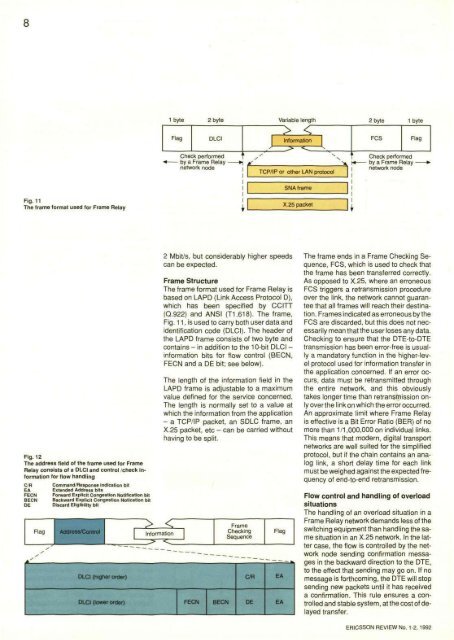8Fig. 11The frame <strong>for</strong>mat used <strong>for</strong> <strong>Frame</strong> <strong>Relay</strong>Fig. 12The address field of the frame used <strong>for</strong> <strong>Frame</strong><strong>Relay</strong> consists of a DLCI <strong>and</strong> control /check in<strong>for</strong>mation<strong>for</strong> flow h<strong>and</strong>lingC/REAFECN6ECNDEComm<strong>and</strong>/Response indication bitExtended Address bitsForward Explicit Congestion Notification bitBackward Explicit Congestion Notication bitDiscard Eligibility bit2 Mbit/s, but considerably higher speedscan be expected.<strong>Frame</strong> StructureThe frame <strong>for</strong>mat used <strong>for</strong> <strong>Frame</strong> <strong>Relay</strong> isbased on LAPD (Link Access Protocol D),which has been specified by CCITT(Q.922) <strong>and</strong> ANSI (T1.618). The frame,Fig. 11, is used to carry both user data <strong>and</strong>identification code (DLCI). The header ofthe LAPD frame consists of two byte <strong>and</strong>contains - in addition to the 10-bit DLCI -in<strong>for</strong>mation bits <strong>for</strong> flow control (BECN,FECN <strong>and</strong> a DE bit; see below).The length of the in<strong>for</strong>mation field in theLAPD frame is adjustable to a maximumvalue defined <strong>for</strong> the service concerned.The length is normally set to a value atwhich the in<strong>for</strong>mation from the application- a TCP/IP packet, an SDLC frame, anX.25 packet, etc - can be carried withouthaving to be split.The frame ends in a <strong>Frame</strong> Checking Sequence,FCS, which is used to check thatthe frame has been transferred correctly.As opposed to X.25, where an erroneousFCS triggers a retransmission procedureover the link, the network cannot guaranteethat all frames will reach their destination.<strong>Frame</strong>s indicated as erroneous by theFCS are discarded, but this does not necessarilymean that the user loses any data.Checking to ensure that the DTE-to-DTEtransmission has been error-free is usuallya m<strong>and</strong>atory function in the higher-levelprotocol used <strong>for</strong> in<strong>for</strong>mation transfer inthe application concerned. If an error occurs,data must be retransmitted throughthe entire network, <strong>and</strong> this obviouslytakes longer time than retransmission onlyover the link on which the error occurred.An approximate limit where <strong>Frame</strong> <strong>Relay</strong>is effective is a Bit Error Ratio (BER) of nomore than 1/1,000,000 on individual links.This means that modern, digital transportnetworks are well suited <strong>for</strong> the simplifiedprotocol, but if the chain contains an analoglink, a short delay time <strong>for</strong> each linkmust be weighed against the expected frequencyof end-to-end retransmission.Flow control <strong>and</strong> h<strong>and</strong>ling of overloadsituationsThe h<strong>and</strong>ling of an overload situation in a<strong>Frame</strong> <strong>Relay</strong> network dem<strong>and</strong>s less of theswitching equipment than h<strong>and</strong>ling the samesituation in an X.25 network. In the lattercase, the flow is controlled by the networknode sending confirmation messagesin the backward direction to the DTE,to the effect that sending may go on. If nomessage is <strong>for</strong>thcoming, the DTE will stopsending new packets until it has receiveda confirmation. This rule ensures a controlled<strong>and</strong> stable system, at the cost of delayedtransfer.ERICSSON REVIEW No. 1-2, 1992
9Fig. 13Applications which use sophisticated graphics<strong>and</strong> there<strong>for</strong>e generate very large files are becomingmore <strong>and</strong> more frequent. Transferthrough the network requires a transmissionspeed of several Mbit s to obtain a reasonable responsetime. Local networks are well adapted tothis requirement, but in wide area network transferthere may be inconveniences, since thesenetworks did not initially have the infrastructurerequired <strong>for</strong> high transmission speeds.In pace with the digitalisation of the wide areanetworks, new communication protocols are nowevolving, the development of them being to alarge extent driven by the dem<strong>and</strong> <strong>for</strong> efficientLAN-to-LAN communication. <strong>Frame</strong> <strong>Relay</strong> is oneexample of this trend<strong>Frame</strong> <strong>Relay</strong> is based on the opposite principle:the network node sends signals tothe DTE only in overload situations. Thismeans simplified h<strong>and</strong>ling, <strong>and</strong> no delayswill occur as long as the traffic is undisturbed.A <strong>Frame</strong> <strong>Relay</strong> network reacts tooverload in two steps:1 When the node registers a tendency towardsoverload, the network requeststhe DTE to reduce its data flow by sendinga Forward/Backward Explicit CongestionNotification (FECN/BECN) consistingof the check bits of the frameheader, Fig. 12. The network takes noaction but leaves it to the DTE to decideon the best way of controlling its dataflow.2 If overload occurs, the network will discardframes.The st<strong>and</strong>ard does not say how the networkwill define the concept "tendency towardsoverload". To exemplify, the nodecan count the number of frames queued<strong>for</strong> access to outgoing lines, or check theCPU load, <strong>and</strong> then send an FECN/BECNsignal when a preset limit value is exceeded.As has been mentioned already, a discardedframe in the network will not result inloss of in<strong>for</strong>mation. The higher-level userapplication protocol checks that the terminatingDTE sends a confirmation of datahaving arrived. If no such confirmation isreceived, retransmission through the entirenetwork will be initiated, resulting in undesireddelays, i.e. longer response time.Transferring the flow control to the DTEclearly involves a risk, since most oftoday's frame-relay-compatible DTEs cannoth<strong>and</strong>le FECN <strong>and</strong> BECN signals. Somesuppliers of equipment capable of h<strong>and</strong>lingFECN/BECN signals recommend usersto switch off the function in order toavoid falling behind when competing <strong>for</strong>transport capacity with equipment withoutthat function.For the simplified flow h<strong>and</strong>ling to functionproperly, each connection from a DTE isallocated a Committed In<strong>for</strong>mation Rate,CIR. This rate is affiliated to the virtual connectionthrough the network, <strong>and</strong> the ratevalue determines how much data the DTEcan send on this connection during a givenperiod of time.The st<strong>and</strong>ard does not give a strict definitionof how to use the CIR value. It could,<strong>for</strong> example, be chosen so that each PVCwould be guaranteed access to a given bitflow, which would basically be the sameas using a leased line. A 2 Mbit/s connectionwould then be able to carry 32 PVCsof 64 kbit/s each. However, a more rationaluse will be ensured by starting from thestochastic traffic characteristics <strong>and</strong> interpretingCIR as a stochastic value of the averageamount of data that a PVC is expectedto carry during a given period of integration.Since the traffic is in the <strong>for</strong>m ofbursts, there is little probability of all sourcessending at the same time. In otherwords, we can allow a PVC to momentarilyutilise a relatively large portion of theavailable transmission capacity, providedthe stipulated average value is kept. At anintegration time of, say, 0.5 s, a CIR valueof 256 kbit/s <strong>for</strong> a PVC will mean that theDTE can use this PVC <strong>for</strong> sending one ormore bursts of altogether 128 kbit duringeach 500 ms interval.Assigning CIR values will facilitate calculationof the traffic flow through the network.When the CIR value is exceeded,the Discard Eligibility bit in the frame head-ERICSSON REVIEW No. 1-2. 1992















